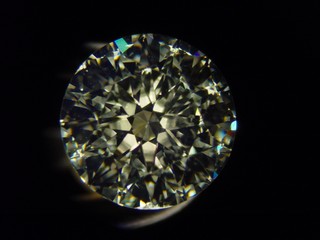Fish Eye in a Diamond: What It Is and How It Affects Appearance
A fish eye is a type of optical flaw that can occur in diamonds, affecting their appearance and overall brilliance. It is typically caused by a shallow cut, which leads to the formation of a visible round or oval-shaped area that looks like the eye of a fish.
What Causes a Fish Eye in a Diamond?
A fish eye typically happens when a diamond is cut too shallow, causing light to enter the diamond at an incorrect angle. When the light exits the diamond, it creates a dark area or a flat, lifeless spot in the centre of the diamond, resembling a fish’s eye. This dark spot results in a significant loss of the diamond’s brilliance.
Key Characteristics of a Fish Eye:
Shape: Usually round or oval, resembling the eye of a fish.
Location: It is typically found near the centre of the diamond, where the light performance is compromised.
Effect on Sparkle: A fish eye causes a lack of brilliance in the affected area, and it may appear as a dark spot or cloudy patch when viewed face-up.
How Does a Fish Eye Affect a Diamond’s Value?
Aesthetic Impact: A fish eye diminishes the diamond’s overall sparkle and brilliance. Because it’s a noticeable flaw, it can detract from the overall beauty of the diamond.
Clarity: A fish eye is typically considered an inclusion, so it can affect the diamond’s clarity grade, especially if it’s visible to the naked eye.
Value: Diamonds with fish eyes usually have lower value, as they are less attractive due to their diminished brilliance.
How to Avoid a Fish Eye in a Diamond
Check the Cut Grade:
A shallow cut is the primary cause of fish eyes, so it’s important to look for diamonds with a well-proportioned cut.
Ideally, choose diamonds with a cut grade of Excellent or Ideal, which ensures proper proportions and minimizes the risk of a fish eye.
Examine the Diamond’s Proportions:
Diamonds that are cut too shallow (too flat) are more prone to fish eyes. Look at the depth percentage and table size to ensure they fall within the ideal range.
For round brilliant diamonds, the depth should ideally be around 59-62%, and the table should be around 53-58% for optimal performance.
Use Magnification:
A 10x loupe can help identify a fish eye in a diamond, especially if it’s located in the center. Make sure to inspect the diamond carefully under magnification before purchasing.
Fish Eye in Diamonds
A fish eye is an undesirable flaw that can occur in diamonds with shallow cuts, resulting in a dark, lifeless spot that compromises the diamond’s overall brilliance. To avoid this flaw, it’s essential to choose diamonds with well-proportioned cuts and ensure that the cut grade is high.
If you’re selecting a diamond and want to avoid the fish eye effect, it’s important to focus on the cut and proportions of the stone. Would you like guidance on selecting diamonds with optimal cut and brilliance?

